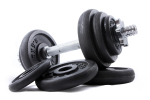- FreeTrainers.com Forums
- General Fitness & Exercise
- *lactic acid build up*
Group: General Fitness & Exercise
Created: 2011/12/31,
Members: 383,
Messages: 54581
Various general exercise related discussions. Find out what it takes to reach your fitness goals through daily effective exercise. With so many options we try to find out what works best.
Join group
*lactic acid build up*

timmstar
Posts:
426
Joined: 2003/12/08  |
2004/06/03, 03:18 AM
um yea read in post something about this and i just want to basically learn what it is and what it feels like if you have it and ways to treat it??? thanks :)
|
|
| |

asimmer
Posts:
8,201
Joined: 2003/01/07  |
2004/06/03, 08:06 AM
Do you want it the way my brain remembers it, or do you want it in textbook form?
Here's the non-textbook version (so it may be a little iffy) Lactic acid is the by-product of energy production in the muscle (and i was just reading an article the other day that said it is actually carbon dioxide, or something, I will have to look all this up because I sound so half-a**ed). Lactic acid causes the burn you feel during yourworkout, meaning you have reached your lactic acid threshold and your body can't fficiently flush out the acid. Your lactic acid threshold increases with your fitness level (which is partially why you don't get as sore as you progress, not to be confused with DOMS, which you can still do quite efficiently :)). One way to decraese the lactic acid is to do a little light cardio and stretching to get fresh, oxygenated blood into your muscles and help 'flush out' the lactic acid. The other type of soreness - the kind that settles in later in the day, or the next day or two, is Delayed Onset Muscle Soreness. It is caused by miniscule tears in the muscles (caused by heavy lifting, etc) and the inflammation that occurs around them as they begin to heal. This is good - this is what makes your muscles grow bigger and stronger. Stretching may help, massage helps, a hot bath always feels good, and occasionally some pain reliever like Advil or Tylenol can be useful. If the pain is debilitating, you can't move a bodypart normally (like not being able to put your heels down all the way, or unbend your arm). You may have sprained or torn a muscle or ligament and you should Ice it and seek a doctor's advice. (I had to wear high heeled shoes for a week cause I demolished my calf muscles a little too well once). Does that give you enough of an answer? I can look up the specifics and find that article if you are interested in a more in-depth explanation. -------------- If you fall down seven times, get up eight. |

Vedakathryn
Posts:
1,585
Joined: 2004/05/28  |
2004/06/03, 11:02 AM
With regard to cardio workouts and Lactic Acid another reason so many people get sore, can't move the next morning ouch, is that they work beyond their means. That is why watching your heart rate and keeping within your allocated span is very important when doing cardio or you will be sore. Where I worked, we would have people that hadn't done a full 30-minute cardio workout in twenty years and yet insisted on bringing their heart rate far above what was recommended and not stretch before and after. The results were very crabby, "I was too sore to come in for three days" individuals and even people that quit because they did not want to feel that pain every morning when they woke up! All they had to do was stretch, allowing the oxygen plentiful blood to your muscles and keep the heart rate where it should be, increasing only as your athletic ability increases. The other difficulty with that is you will no longer be burning fat - you will start to eat at your muscle as your body goes into a hyper emergency mode when the muscles are lacking in the sufficient amount of oxygenated blood as your heart is beating away trying to keep up. The body then thinks it has to leave the fat alone, and searches for the muscle to knaw away at. This is a a hard lesson for many as they often feel that to raise the heart rate higher, workout harder - until they can hardly breathe is the only way to successfully burn calories - but why do a cardio workout if you aren't going to burn as much fat and you are going to hurt terribly in later in the day or in the morning? As asimmer said, one pain is a "good" pain, the other is telling you to do your workout right. -------------- MISERY IS OPTIONAL SMILES FOR MILES |

Woodie
Posts:
148
Joined: 2004/04/28  |
2004/06/03, 11:03 AM
Well, I had beter be careful with my calves. I don't look to good in heels.-------------- Woodie. |

asimmer
Posts:
8,201
Joined: 2003/01/07  |
2004/06/03, 11:43 AM
:laugh::laugh:-------------- If you fall down seven times, get up eight. |

bb1fit
Posts:
11,105
Joined: 2001/06/30  |
2004/06/03, 06:18 PM
The very worst thing you can do is for instance taking curls, really burn the biceps up...lactic acid pools in the biceps. This will hinder nutrient flow, do not just lay around after a real burn in your muscles. About 5 minutes of a decent paced cardio would be ideal to get nutrient rich blood flowing and move the lactic acid pools out.:big_smile:-------------- If you don't stand for something, you will fall for anything.... bb1fit@freetrainers.com |

bigandrew
Posts:
5,146
Joined: 2002/10/21  |
2004/06/03, 07:39 PM
I herd drinking milk helps get rid of lactic acid? somthing about the lactose helps get rid of the acid?-------------- .......adversity causes some to break, but others to break records! ......minds are not vessles to be filled, but fires to be enlightened ......Confucious once said ,DO NOT play leap frog with a unicorn |

timmstar
Posts:
426
Joined: 2003/12/08  |
2004/06/04, 03:14 AM
wow lol didnt really expect this many posts, um does lactic acid have anything to do with bones or something? i was talking to this guy who said it also comes from calcium or milk or something as well which helps something a rather along the lines andrew just said is that true i dno but does lactic acid have anything to do with calcium or bones??.. thanks :)
|

Vedakathryn
Posts:
1,585
Joined: 2004/05/28  |
2004/06/04, 11:35 AM
Here is some FYI on Lactic Acid, you can see that there is also reference to "milk", as lactic acid sours milk...
Lactic Acid is a colourless compound produced by almost all tissues in the human body, necessary for the body to function daily. Lactic acid is produced and circulates through your bloodstream all the time, albeit in small amounts. Lactic acid, like Creatine, can also be produced synthetically, for use in biodegradable polylactic acid products (PLA). Although, why you'd want to supplement with Lactic Acid is anyone's guess. Lactic acid is usually formed by fermentation of glucose, a carbohydrate, by a process called glycolysis. This is a chemical process in which glucose is broken down to pyruvic acid, and carbon dioxide, water, and energy (ATP) are released. If there is an excess of pyruvic acid, lactic acid is then formed. However, this is a reversible reaction. When the Lactic acid receives oxygen, it is converted back to pyruvic acid, for later use by the body. The lactic acid is carried by the blood from the cramped muscles to the liver where it converted back to pyruvic acid, and then to carbon dioxide, water and ATP. Lactic acid is a by-product, produced by the body's tissues, primarily muscle, in order to obtain energy by metabolising glucose in the absence of oxygen. The glucose is either supplied from the blood stream or from it's stored form, glycogen, in the muscles. This is called anaerobic respiration (without oxygen). Lactic acid (in large amounts) is usually formed during strenuous exercise, and a large amount of lactic acid in muscle leads to fatigue and can cause muscle cramps. Lactic acid also causes the souring of milk, by fermentation of lactose. This makes Lactic acid useful commercially, as it is used in preparing cheese, sauerkraut, soft drinks, and various other food products. When you train hard, you usually get that burning sensation in the muscles that you're working. This "burn" is caused by an excess of Lactic acid in those muscles. If you are exercising past the point where you cannot provide a sufficient supple of oxygen to the working muscles, lactic acid will accumulate in the working muscles and the blood stream. Bear in mind when training to failure that muscle failure cannot be achieved without feeling a burning sensation, and you are not pushing yourself to muscle failure if so. This is called training at a Sub-Lactic acid level. At a Lactic acid level this means that you are feeling a strong lactic acid build-up, or burn in the working muscles on your last two repetitions. You should struggle on your last two repetitions. This is why so many personal trainers say "Feel the burn!" Although if said trainers do repeat this ad nausem to you whilst you are on your last rep of bench pressing 300lbs, you have my full permission to beat them up. Unless they're bigger than you, of course. Occasional training to failure actually improves aerobic conditioning. Intense exercise that produces lactic acid raises muscular endurance quicker than moderate exercise alone, because as you improve with training, the now fitter muscles process the lactic acid quicker, therefore the less often you experience the burn. The best way to get rid of the lactic acid in your cramped muscles is to keep exercising at a slower pace. Lactic acid is removed more quickly during walking than during complete rest, as you are keeping your blood flow steady and constant. So, cooling down allows the blood to continue to flow through the muscles, allowing the lactic acid to be carried to the liver to be converted back to pyruvic acid. Adequate rest should be taken between heavy sets, just enough so that you can supply oxygen to your muscles to reduce the lactic acid buildup. If you don't, the large lactic acid buildup will make you feel tired and nauseous after your workout. So, to conclude, periodically going for "the burn" is a good thing, but just remember to rest between heavy sets, breathe deep, and to cool down adequately after any strenuous training. -------------- MISERY IS OPTIONAL SMILES FOR MILES |

edj1963
Posts:
15
Joined: 2007/08/04  |
2007/08/13, 05:48 PM
Question: I walk a treadmill for my cardio letting the machine keep me at about 180% of max...I am getting a lactic acid build up like after 15 minutes, it passes by the end but I'm worried that Muscle is catabolising, is this a danger? Trust me when I say I cant aford to lose ANYTHING lean LOL
:big_smile: Is there anything I can take as a suplement to stop it? assuming Im destroying muscle...? or is this just the price for being SO out of shape? |
